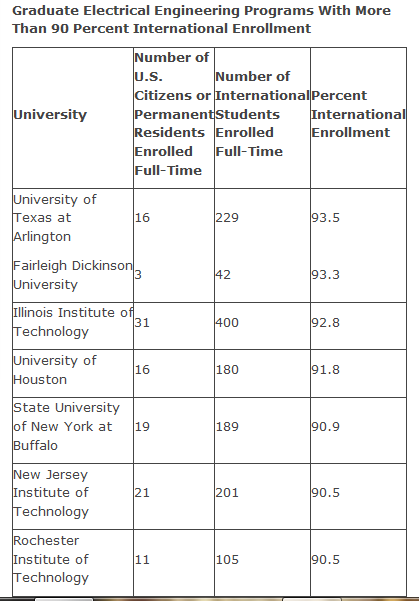Outsourcing STEM Degrees: American graduate programs dependent on foriegn students
A new report provides a breakdown on international enrollments by discipline and institution, showing that some technical and science graduate programs contain more than 90 percent foreign students.
Elizabeth Redden of Inside Higher Ed analyzes the numbers:
International students play a critical role in sustaining quality science, technology, engineering and mathematics (STEM) graduate programs at U.S. universities, a new report from the National Foundation for American Policy (NFAP) argues.
It will come as no surprise to observers of graduate education that the report documents the fact that foreign students make up the majority of enrollments in U.S. graduate programs in many STEM fields, accounting for 70.3 percent of all full-time graduate students in electrical engineering, 63.2 percent in computer science, 60.4 percent in industrial engineering, and more than 50 percent in chemical, materials and mechanical engineering, as well as in economics (a non-STEM field). However, the report, which analyzes National Science Foundation enrollment data from 2010 by field and institution, also shows that these striking averages mask even higher proportions at many individual universities. For example, there are 36 graduate programs in electrical engineering where the proportion of international students exceeds 80 percent, including seven where it exceeds 90. (The analysis is limited to those programs with at least 30 full-time students.)
The following table summarizes the situation for one field of study:
New report shows dependence of U.S. graduate programs on foreign students. (Inside Higher Ed | News)








Comments
As a computer programmer with a brother in electrical engineering, my experience is that graduate degrees in some tech fields are pursued for career advancement by Americans. A B.S. is sufficient to find a job, and when considering career advancement a M.B.A. is often preferred in corporate America.
Also, this is a reflection of the perceptual difference between the U.S. and foreign university degrees. For instance, some foreign degrees are not recognized in the U.S.
American high schools have become dismal failures are preparing students for math and science majors. Ed majors are a poor substitute for real science training. Guess it’s more important to have a catchy label (STEM) than to have any substance behind it.